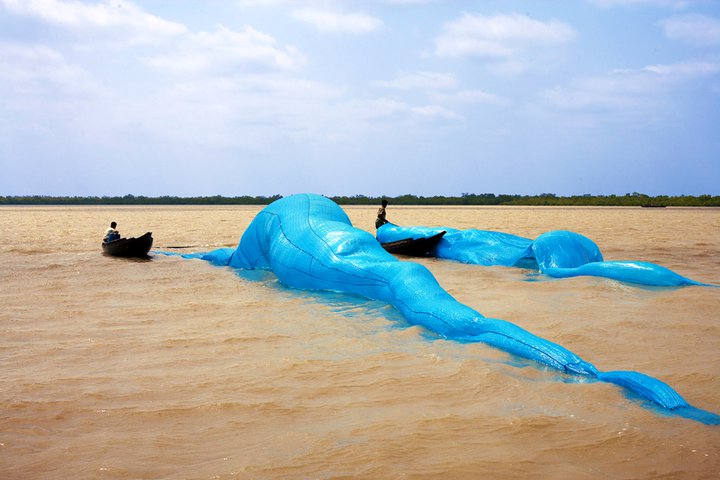Increasing numbers of loud and littering tourists are damaging the world's largest mangrove forest, which stretches from Bangladesh to eastern India and is home to Royal Bengal Tigers and a colorful collection of other wildlife that includes spotted deer, birds, crocodiles, and various species of snakes.
The mild weather of winter at the moment is sure to draw visitors to the Sundarbans forest, and with it throngs of tourists whose careless picnicking and sightseeing destroy the environment and disturb the animals. Nearly 100,000 local and international tourists [bn] flock to this UNESCO world heritage site each year, with that number increasing each year by 20-30 percent.
This issue has fueled debate in local media and the local blogosphere.
Iftekher Mahmud, a journalist for The Daily Prothom Alo newspaper, wrote about his travel experience [bn]:
বেলা গড়িয়ে সকাল ১০টা বাজতেই লঞ্চ আর ছোট জালি নৌকায় পর্যটকদের আনাগোনা বেড়ে গেল। মাইকে বিকট শব্দে হিন্দি গান বাজতে বাজতে একটার পর একটা লঞ্চ বনের ভেতরে হানা দিতে লাগল। পর্যটকদের লঞ্চ চলে যাওয়ার সময় সুন্দরবনের পরিবেশের জন্য মারাত্মক ক্ষতিকারক চিপসের প্যাকেট ও পলিথিন নদীতে ভাসতে দেখা গেল।
The tourists start pouring in on steamboats and smaller rowboats by 10 in the morning. The steamboats blast loud beat music as they cruise through the rivers deep in the forest. The tourists litter empty plastic potato chip packs and polythene bags in the river from the steamboat, causing much harm to the environment.
Tareq Onu, a bird watcher, wrote on his Facebook page [bn] during a visit to the Sundarbans:
কিছু অসভ্য মানুষ দেখলাম যারা বনের ভিতরে, নদীর জলে প্লাস্টিকের ব্যাগ, বোতল নির্বিকারে নিক্ষেপ করে এবং তারস্বরে মাইক বাজিয়ে গান শোনে। এরা কেন আসে সুন্দরবনে!
Saw some uncivilized people who carelessly threw plastic bags and bottles into the river and played loud, irritating music inside the forest. Why do these people visit the Sundarbans?
Mohammed Arifur Rahman Chowdhury [bn], a commenter on the Prothom Alo Article, said that he considered tourists such as these to be ignorant:
আমরা এখনো অশিক্ষিত পর্যটক, আমার এখনো জানিনা কোন এলাকাতে কি ভাবে ভ্রমণ করতে হয়। বনের সোন্দর্য বিকট শব্দে গান বাজিয়ে হই হুল্লোড় করে উপভোগ করা যায় না।
As tourists, we are extremely ignorant. We still don’t know what travelling etiquette is and how not to disturb nature. You cannot enjoy the serenity of the Sundarbans by playing loud music.
The number of vessels traversing the many rivers in the Sundarbans has also grown. In 2011, 25 ships and cargo vessels sailed in the area, but only a year later that number had spiked to more than 130. Every day that these vessels blast their hydroelectric horns and release contaminated exhaust and oil waste, they destroy the Sundarbans environment a little more.
Fishermen also destroy the forest in search of fish. Shopnobalok Ami [bn] wrote on somewhereinblog:
মাছ বা কাঁকড়া ধরতে কিংবা শামুক-ঝিনুকের খোঁজেও যারা যান তারা যে স্রেফ মাছ-কাঁকড়া-ঝিনুক নিয়ে ফেরেন তা নয়। পথে গাছ কেটে নৌকায় তুলে কিংবা নৌকার সঙ্গে বেধে ভাসিয়ে নিয়ে আসেন।
The fishermen who go to catch fish or crabs or snails sometimes cut down trees from the forest and bring them back tied to their boats along with the day’s catch.
But there is hope. In an effort to end irresponsible tourism and to promote eco-tourism in the Sundarbans, the government has drafted legislation [bn] that would prohibit tourists from carrying any items that may cause damage to the environment. Items such as microphones, megaphones, chemical products, plastics, and discarded foodstuff would not be allowed to be dumped into the river, and boats would be required to have proper waste disposal systems on board.








